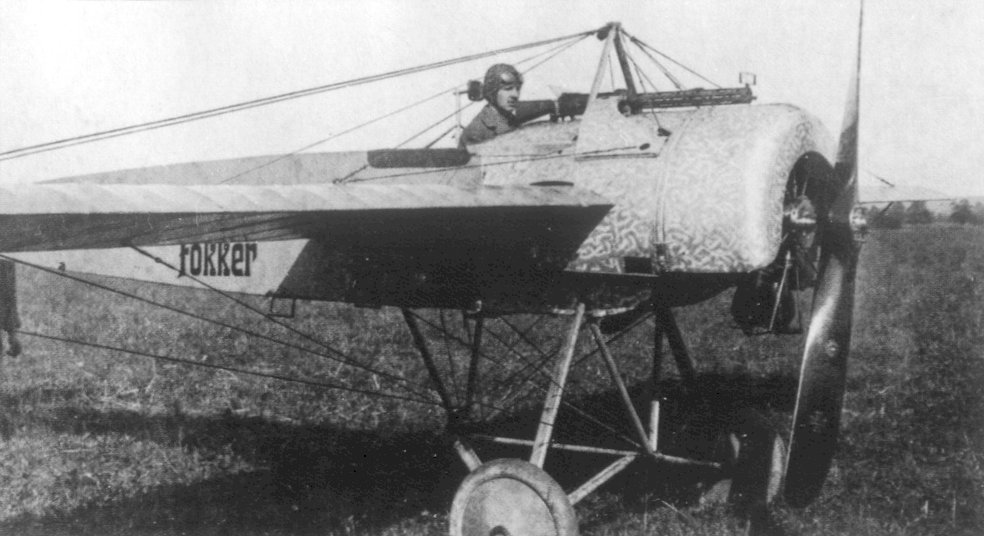- Fokker E.II
Infobox Aircraft
name = Fokker E.II
type = Fighter
manufacturer =Fokker 
caption = The first production Fokker E.II
designer =Anthony Fokker
first flight =13 June 1915
introduced = June 1915
retired =
status =
primary user = Imperial German Army Air Service
more users =
produced = 1915
number built = 49
unit cost =
variants with their own articles =Fokker E.I ,Fokker E.III The Fokker E.II was the second variant of the GermanFokker Eindecker single-seat monoplanefighter aircraft of theFirst World War . The E.II was essentially aFokker E.I with the 100-hp Oberursel U.I 9-cylinderrotary engine , a close copy of the French Gnôme Monosoupape rotary of the same power output, in place of the E.I's 80-hp Oberursel U.0, but whereas the E.I was simply a M.5K with a machine gun bolted to it, the E.II was designed with the weapon system integrated with its airframe.Design and development
On
13 June ,1915 ,Anthony Fokker demonstrated the first E.II to an audience of German commanders, includingCrown Prince Wilhelm of Germany , at aGerman Fifth Army airfield. On 23 and24 June he demonstrated the aircraft atDouai to theGerman Sixth Army . It was during these demonstrations, before any kills had been achieved in the Eindecker type, that Fokker himself attempted to engage an enemy aircraft but he was unable to find a target.The major difference between the types was a reduced wingspan on the E.II, intended to increase speed, but handling and climbing performance suffered. The type was therefore quickly superseded by the E.III. The E.II also had a larger fuel capacity, 145 lb (66 kg) to the E.Is 110 lb (50 kg). The pilot was provided with a head support to help him resist the airstream when he had to raise his head to use the gun sights.
The larger diameter of the Oberursel U.I 100hp rotary engine necessitated a larger diameter "horseshoe" pattern cowl to enclose it, and the aluminum upper deck of the nose was raised along with it-resulting in metal
soffit s having to be fitted where the upper deck met the upper longerons, with additional structural metal tubing additions to the forward ends of the upper longerons immediately behind the firewall to support the "soffits" and sides of the raised upper nose panel. This format was continued with the E.III.The E.II was built in parallel with the E.I and the choice of whether an airframe became an E.I or E.II depended on the availability of engines. In total, Fokker production figures state that 49 E.IIs were built and 45 of these had been delivered to the Western Front "Fliegertruppe" by December 1915 at which time production switched to the main Eindecker variant, the
Fokker E.III , which used the same 100-hp Oberursel U.I engine. Some E.IIs under production were completed as E.IIIs and numerous E.IIs returned to Fokker's factory for repair were upgraded to E.III specification.Operators
*
pecifications (E.II)
aircraft specifications
plane or copter?=plane
jet or prop?=prop
ref=
crew=one, pilot
capacity=
payload main=
payload alt=
length main= 7.2 m
length alt= 23 ft 7 in
span main= 9.7 m
span alt= 31 ft 10 in
height main= 2.8 m
height alt= 9 ft 5½ in
area main= 16 m²
area alt= 172.2 ft²
airfoil=
empty weight main= 340 kg
empty weight alt= 745 lb
loaded weight main= 500 kg
loaded weight alt= 1,098 lb
useful load main=
useful load alt=
max takeoff weight main=
max takeoff weight alt=
more general=
engine (prop)=Oberursel U.I
type of prop=9-cylinder air-cooledrotary engine
number of props=1
power main= 100 hp
power alt= 74.5 kW
power original=
max speed main= 87 km/h
max speed alt= 54 mph
cruise speed main=
cruise speed alt=
stall speed main=
stall speed alt=
never exceed speed main=
never exceed speed alt=
range main=
range alt=
ceiling main=
ceiling alt=
climb rate main=
climb rate alt=
loading main=
loading alt=
thrust/weight=
power/mass main=
power/mass alt=
more performance=
armament=
* 1x forward-firingMaschinengewehr 08 machine gun
avionics=References
ee also
aircontent
related=Fokker E.I -Fokker E.III similar aircraft=
lists=
*List of military aircraft of Germany see also=
Wikimedia Foundation. 2010.
